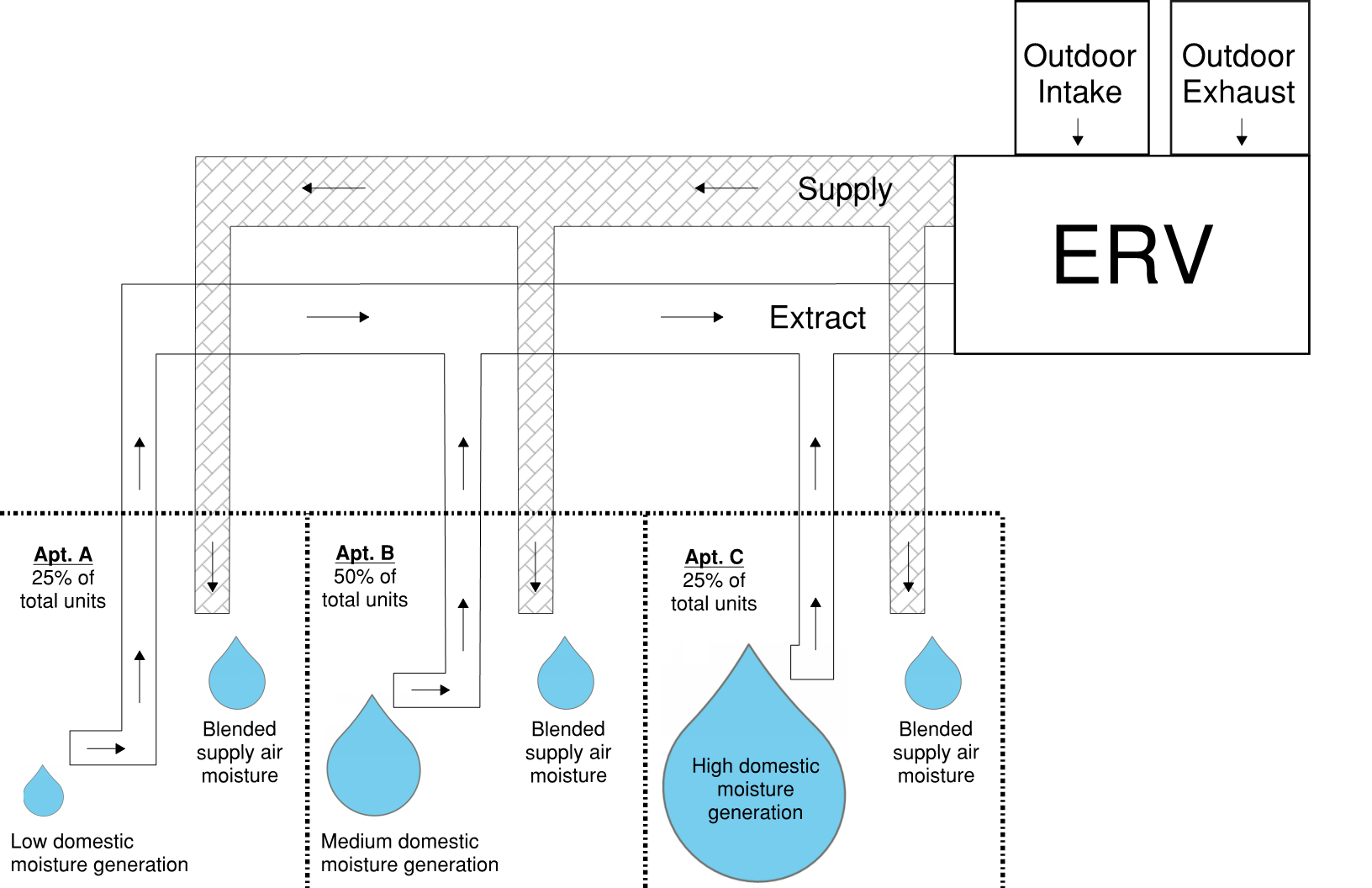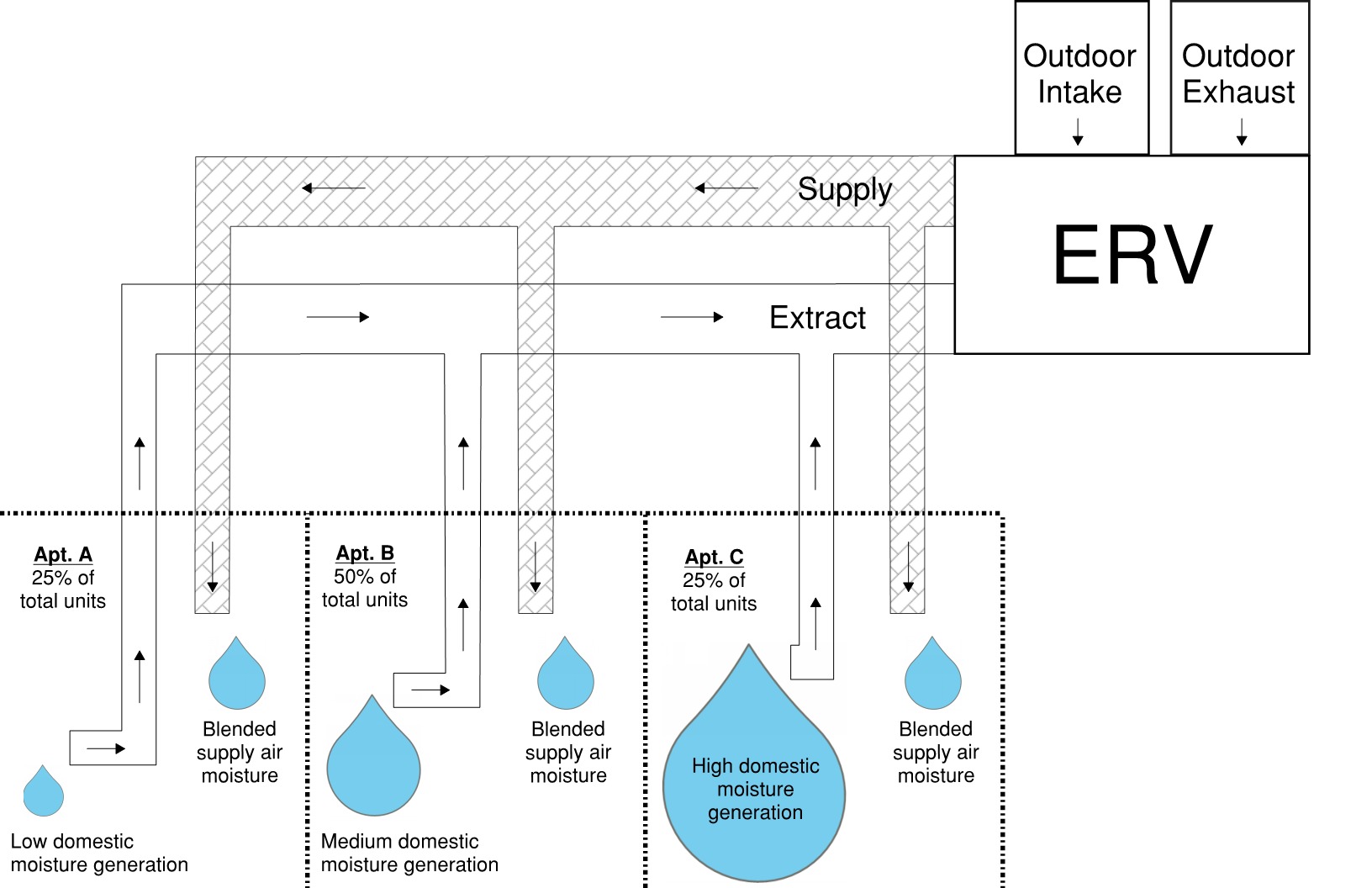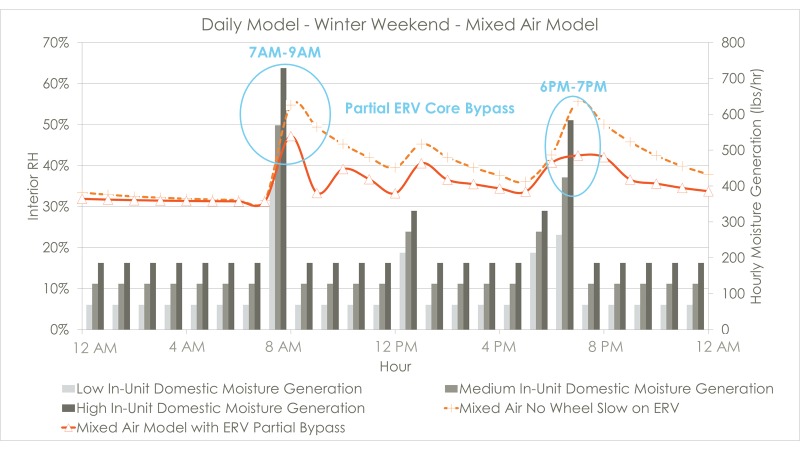

Blog
Domestic moisture generation—moisture from human activity—is a major factor driving the humidity levels in our residential buildings, especially in super air-tight, Passive House construction.

Most of us are familiar with the feeling of a humid apartment after taking a hot shower. Some of us kick on an exhaust fan, perhaps un-fog the bathroom mirror, or even open a window to get the moisture out. Domestic moisture generation—moisture from human activity—is a major factor driving the humidity levels in our residential buildings, especially in super air-tight, Passive House construction. Before diving into just how much of an impact domestic moisture has in our buildings, let’s first look at average daily moisture generation rates of a typical family of three[1]:
This brings the daily total to 11.1 to 14.6 pounds of moisture generation per day, or about 1.5 gallons of liquid water.
Where does all of this moisture go? In a typical code-level apartment building with moderate to high-levels of air leakage, water vapor has two year-round exit pathways: exfiltration through the façade and dedicated kitchen or bathroom mechanical exhaust. Additionally, in the summer, moisture is removed via condensate from the cooling system.
Let’s now put this in the context of a highly energy-efficient apartment with very low levels of air leakage (about 5 to 10 times less than the code-compliant unit), and balanced ventilation with energy recovery. The first means of moisture removal, façade exfiltration, is virtually non-existent given the building’s superior air-tight design. Next is mechanical exhaust ventilation in the kitchens and bathrooms. Because the unit has balanced ventilation and energy recovery, the exhaust air stream in a Passive House project typically passes through the energy recovery core. Depending on the core selection, a large percentage of the interior moisture may be retained in the apartment air despite the constant mechanical air exchange.
To fully understand this issue, Figure 1 breaks break down the moisture-related pros and cons of ERVs and HRVs in the context of a high-density, Passive House building.
| ERV | HRV | |
| Pros | Summer – prevents high exterior air moisture load from being supplied to interior air; cooling loads are minimized | Winter – flushes high internal moisture load out of building; humidity levels reduced |
| Cons | Winter – if internal moisture generation is high, interior moisture load is not flushed out of apartment; humidity levels increase | Summer – allows exterior air moisture load to be supplied to interior air: cooling loads increase |
Traditionally, the key factor in deciding between an ERV or HRV for a high-efficiency building has been the project’s climate. However, as internal moisture loads begin to exceed exterior moisture loads in high-density projects, the decision between ERV or HRV must be looked at more closely for each project regardless of climate.
Our Passive House team at Steven Winter Associates, Inc. closely studied this dynamic relationship between interior humidity levels and the ERV vs. HRV decision for a 277 unit high-density, affordable housing Passive House project in New York City. The project team originally elected for decentralized ERVs, one unit per apartment, to reduce summertime cooling loads, resulting in utility savings for the buildings’ tenants. Given this decision, we underwent a major modeling effort to assess the risk of high winter-time interior humidity levels, an ingredient for increased condensation potential on the project’s windows. Two primary questions needed to be answered:
Goal #1: Will interior relative humidity (RH) levels get high enough in the wintertime to cause condensation potential on the windows?
Goal #2: Is the ERV’s airflow boost capacity enough to mitigate high interior humidity levels?
This modeling exercise yielded the following takeaways:
Decentralized ERV Moisture Analysis
Takeaway #1: Weekday interior RH levels will peak anywhere from 50% to 63% in the morning and early evening. The largest peak will occur during the morning-breakfast hours.
Takeaway #2: Weekend interior RH levels will remain between 50% and 70% over the course of the day.
Takeaway #3: Boost flow on the ERV during high-humidity conditions will only slightly reduce peak humidity levels.
Takeaway #4: Due to high-predicted interior humidity levels, localized supplemental dehumidifiers may be required.
Takeaway #5: Some ERV cores can have a much greater moisture recovery rate in the winter season than in the summer. These seasonal differences are not typically reported by manufacturers and should be confirmed for each project.
As the project progressed, a decision was made to switch to 4 centralized ERVs. The model was then revised to account for a normalized amount of “air mixing” that would occur with the centralized design. See Figure 2 for a schematic of this concept. In other words, not all apartments will be generating high levels of moisture at any given time. Therefore, the supply air going back to each apartment will result from a blending of the average humidity conditions across the project’s 70 units that each centralized ERV receives.

The revised moisture model, which was based on using centralized ERVs, yielded a noticeable reduction in apartment interior RH when compared to the decentralized model. On a typical weekend day in winter, the model was predicting the average apartment interior RH percentages would remain in the low to mid 50s for only a few hours during those times when domestic moisture generation peaks.
While the centralized ventilation approach largely reduces the risk of high moisture levels in the apartments, additional controls are being specified for the centralized ERV units to further alleviate this risk. During periods of cold exterior air temperatures and high return air humidity levels, the ERV will have the ability to partially bypass the enthalpy wheel to flush the moisture out of the apartment air. Figure 3 depicts the substantial effect of incorporating this ERV control.

Our modeling shows that this approach of utilizing partial core bypass controls on the ERV effectively mitigates high interior RH levels in the wintertime, and reduces the risk of condensation on the project’s windows. However, this approach is certainly not ideal. During periods of partial core bypass, heating loads will increase due to the reduced rate of sensible heat recovery from the exhaust air streams.
It is rare to find a perfect solution to a problem. Because we have very little control over domestic behavior, we’ll likely need to lean on engineered solutions to grapple with unpredictable behaviors and interior humidity. Cooling systems are a good place to start. Cooling systems that better match the low loads in Passive Houses could enhance their dehumidification potential in the summer, thus making HRVs more favorable for projects. HRVs will completely flush moisture out of the apartment air during the winter months when a risk of condensation may be present. Another thought is to take a page out of Intel’s book and incorporate “dual-core” technology in our ventilators. The potential solution could be a ventilator that automatically switches from an ERV to an HRV core from season to season. Whatever the actual solutions may be moving forward, it’s critical we begin to think about them. This issue will become more prevalent as we design tighter, denser multifamily buildings.
As seen in Passive House Buildings Magazine
[1] TenWolde, Anton; Pilon, Crystal L. 2007. The effect of indoor humidity on water vapor release in homes. In: Proceedings, ASHRAE thermal performance of the exterior envelopes of whole buildings X : U.S. Department of Energy, Oak Ridge National Laboratory: Buildings X Conference, 2007 Dec. 2-7. Atlanta, Ga.: American Society for Heating, Refrigerating, and Air-Conditioning Engineers, Inc. 9 p.
Dylan Martello